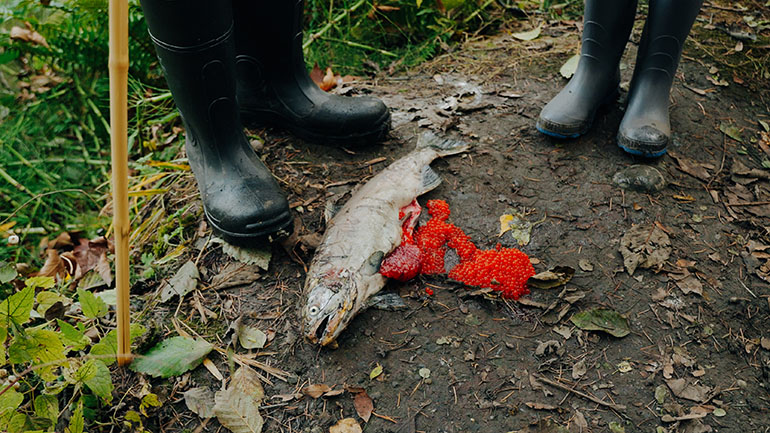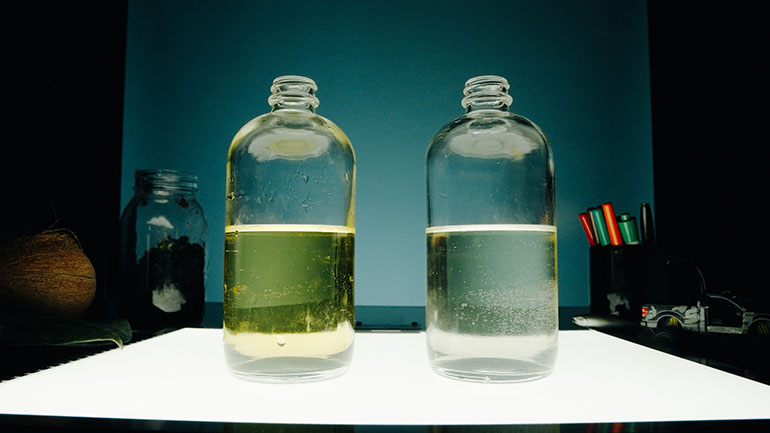VIDEO: King County scientists identify a potential breakthrough for treating salmon-killing tire chemical
Summary
March 27, 2025: Research by King County's Water and Land Resources Division confirmed the effectiveness of soil mixture that treats 6PPDQ, a toxic chemical found in tire dust that causes coho salmon to die before they return to their spawning grounds.
News
King County scientists have identified a potential breakthrough in the longstanding problem of coho salmon dying from exposure to polluted stormwater before they can spawn with a new soil mixture that has is highly effective at treating a toxic chemical found in tire dust.
The King County Water and Land Resources Division and its partners are working together to verify the initial study results, map toxic hotspots in local spawning streams, and offer the new treatment option to make stormwater cleaner and safer for people and fish. Scientists are now building on laboratory success to better understand and address the toxic chemical, known as 6PPDQ, that is killing coho salmon before they reach their spawning grounds.

“Coho salmon dying from exposure to a toxic tire chemical just before they return to their spawning ground after their journey to the Pacific is not just a tragedy – it’s an urgent call to action,” said John Taylor, Director of the King County Department of Natural Resources and Parks. “Our scientists joined their peers to identify a promising solution to a lethal challenge, one that can contribute to the survival of a native salmon species.”
The recently discovered 6PPDQ is found in all tire dust. Rain washes the toxic chemical from roadways into waterways, where it kills adult salmon preparing to spawn. It was first isolated and identified by Zhenyu Tian, an environmental chemist at the Center for Urban Waters at UW Tacoma.
Before 6PPDQ was discovered, a collaborative group – the cities of Redmond and Tacoma, King and Kitsap counties, consulting firm Herrera Environmental Inc., and academic researchers – partnered to develop a new soil mixture to optimize the treatment of stormwater. The mixture performed well but its ability to treat the toxic tire chemical was untested until scientists at King County’s Water and Land Resources Division and researcher Curtis Hinman completed a recent laboratory study demonstrating the new soil mixture effectively removes it from stormwater.
The study showed that while nearly 100% of coho placed in unfiltered stormwater died, there was a 100% survival rate for the coho placed in stormwater that had been filtered through the new soil mixture. The soil mixture includes prescribed amounts of sand, coconut fiber, and biochar that stormwater runoff slowly filters through, removing pollutants and excess nutrients as it percolates into the ground.

More research is coming, including a full-scale pilot project in Whatcom County where scientists hope to confirm the soil mixture’s effectiveness seen in the laboratory setting in real-world conditions by the end of this year.
“It's not every day that we get to say with certainty that we can solve such a complicated problem, but I feel hopeful about this one,” said Josh Latterell, who leads King County’s Science Section in the Water and Land Resources Division. “This issue isn't unique to King County, but King County is uniquely positioned to do something about it and our researchers are building a whole toolkit of strategies that will make cleaner, safer water a reality.”
Identifying the best locations to apply the new soil mixture
The Water and Land Resources Division and King County Road Services – with support from the Washington State Department of Transportation and funding from the state Department of Ecology – are working to identify roadways with higher concentrations of 6PPDQ, creating a prioritized list for new and additional stormwater treatments. King County scientists are also working with the U.S. Department of Interior’s Geological Survey and state Department of Ecology to test an alternative water sampling technology that could be a quicker approach for determining the most and least 6PPDQ impacted streams.

To ensure that developers in King County can use the latest and best technologies available to treat stormwater, the Water and Land Resources Division has updated its stormwater management guidance ahead of schedule to allow the new bioretention soil mixture for stormwater treatment in unincorporated areas.
King County’s Water and Land Resources Division – one of four divisions at the Department of Natural Resources and Parks – will continue its work to improve stormwater treatment, including collecting and analyzing new data, exploring strategic partnerships, publishing a 6PPDQ action plan later this year, and building on collaborations with partners across the region.
“The urgency of the 6PPDQ problem is leading to a lot of research, coordination, resources, and general societal investment,” said Chelsea Mitchell, a Senior Ecotoxicologist in the division’s Science Section. “I think if we keep up this momentum and investment, we can tackle the problem with aggressive source control and stormwater treatment. Plus, the treatments that are effective for 6PPDQ also mitigate other toxic stormwater contaminants, so we can address many of these problems at the same time.”
Multimedia
- VIDEO: Treating salmon-killing toxic tire chemical
- PHOTO GALLERY: Treating salmon-killing toxic tire chemical
- TRACKS: An interactive map of environmental stewardship in King County
Resources
Quotes
Coho salmon dying from exposure to a toxic tire chemical just before they return to their spawning ground after their journey to the Pacific is not just a tragedy – it’s an urgent call to action. Our scientists joined their peers to identify a promising solution to a lethal challenge, one that can contribute to the survival of a native salmon species.
It's not every day that we get to say with certainty that we can solve such a complicated problem, but I feel hopeful about this one. This issue isn't unique to King County, but King County is uniquely positioned to do something about it and our researchers are building a whole toolkit of strategies that will make cleaner, safer water a reality.
The urgency of the 6PPDQ problem is leading to a lot of research, coordination, resources, and general societal investment. I think if we keep up this momentum and investment, we can tackle the problem with aggressive source control and stormwater treatment. Plus, the treatments that are effective for 6PPDQ also mitigate other toxic stormwater contaminants, so we can address many of these problems at the same time.
Contact
Doug Williams, Department of Natural Resources and Parks, 206-477-4543

 Translate
Translate